Nanook of the North (1922) and Une Partie de Campagne (1936-37)
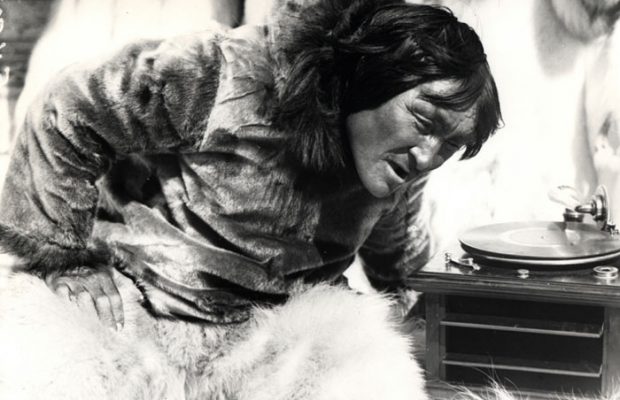
Toronto Film Society presented Nanook of the North (1922) and Une Partie de Campagne (1936-37) on Monday, October 13, 1952 as part of the Season 5 Main Series, Programme 2.
SECOND EXHIBITION MEETING – FIFTH SEASON
Monday, October 13, 1952 8.15 p.m. sharp
Royal Ontario Museum Theatre
The Odyssey of a Film Maker
The first 15 minutes of the programme will be devoted to the playing of a recorded talk by Robert Flaherty describing his experiences as an explorer-film maker.
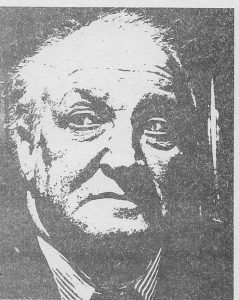
Robert J. Flaherty 1884-1951
Nanook of the North (1922)
PRODUCTION: Revillon Frères
DIRECTION: Robert J. Flaherty
PHOTOGRAPHY: Robert J. Flaherty
EDITING: Carl Stearns Clancy
Grierson (on the death of Flaherty): “It has been mentioned often that there were two Nanooks; that the first went up in a blaze in Toronto–or was it Montreal?–and that poor Flaherty had, like (Thomas) Carlyle with his French Revolution, the dreadful task of going into the wilds to do it all over again.”
Flaherty’s rebuttal to myths about his early films (Cinema 1950): “Sometime after this expedition returned–we were away for a year and a half–I took up the matter of the film I had shot. I was getting it together in Toronto to ship to New York when carelessly, amateur that I was, I dropped a cigarette in the little room where the film happened to be. It caught fire and some 70,000 feet of negative went up in a flash of flame. However, there was an edited print of the negative that escaped the fire. … It was utterly inept, simply a scene of this and a scene of that. … It bored me.”
“My wife and I thought it over for a long time. At last we realized why the film was bad, and we began to get a glimmer that if I went back to the North, where I had lived for ten years and knew the people intimately, I could make a film that this time would go. Why not take .. a typical Eskimo and his family and make a biography of their lives through a year. .. Here is a man who has less resources than any other man in the world. .. His life is a constant fight against starvation. .. He must depend utterly on what he can kill; and all this against the most terrifying of tyrants–the bitter climate of the North.”
Several years later Flaherty persuaded the fur company of Paris, Revillon Frères to finance his film. He travelled North by canoe carrying with him equipment to shoot, develop and print on location.
“My printing machine was an old English Williamson Printer that screwed to the wall. I soon found when printing the film by the printer that the light from my little electric plant fluctuated too much; so I abandoned electric light and used daylight instead by letting in an inlet of light just the size of a motion picture frame through the window, and I controlled this daylight by adding or taking away pieces of muslin from before the printing aperture of the printer.”
“The washing of the film was the worst of all. My Eskimos had to keep a hole chiselled through six feet of ice all through the winter and then haul the water in barrels .. to my hut, and there we all with our hands cleared out the ice from the water and poured it for the necessary washes over the film. ..”
“It has always been most important for me to see my rushes–it is the only way I can make a film. But another reason for developing the film in the North was to project it to the Eskimos so that they would accept and understand what I was doing and work together with me as partners.”
After editing the film in New York, Flaherty took it from one distributor to another: they told him it could not be shown to the public and could never be run as a feature. Finally Pathé took it and the problem remained to sell it to Roxy, the film exhibitor who ran the biggest theatre in New York. “We knew very well that to show it to Roxy cold was to invite failure. .. The sister of the publicity head of Pathé was a great friend of Roxy’s. So it was arranged to show it first to her and some of her friends and tell them where to applaud through the picture, and then they would come along to the showing to Roxy… We also told them never to talk directly to Roxy about the film but to talk to each other across him as if he were not in the room. Well, by the time the film was over, Roxy was tearing his hair. He used such words as ‘epic’, ‘masterpiece’ and the like. … So Nanook came out at the Capitol Theatre.” But it was not until after its sensational successes in Europe that it was really accepted in America.
Nanook of the North appeared three years before Potemkin
and seven years before the development of the British
documentary, of which it was one of the sources.
Neighbors Canada 1952 3 mins
NORMAN MCLAREN ok’d the test print of his latest film before leaving for India last week. The Society is indebted to Mr. Guy Glover and the National Film Board of Canada for permitting us to screen it before general release. Neighbors is in McLaren’s new “pixillation” technique.
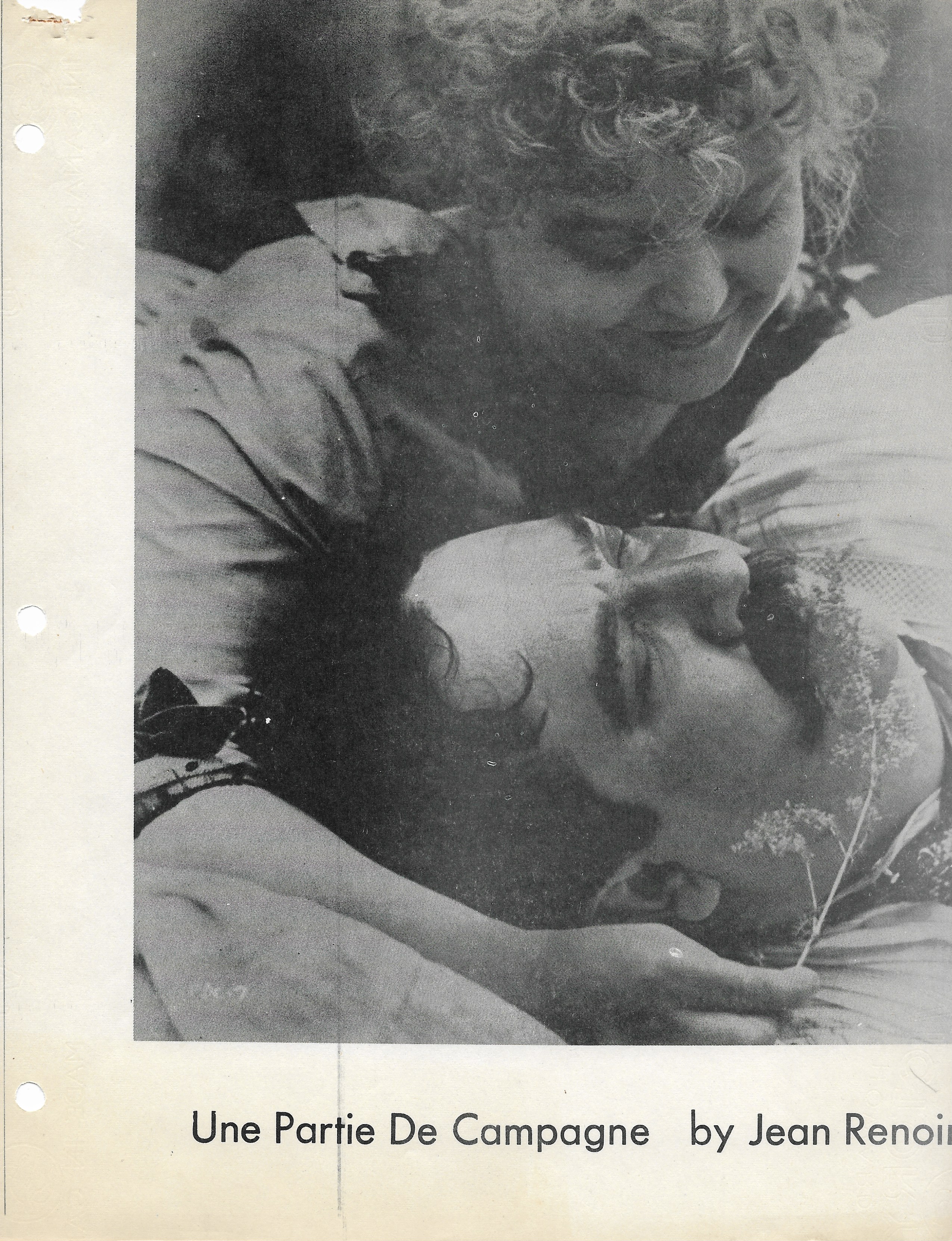
Une Partie de Campagne (1936-37)
A Day in the Country
DIRECTION: Jean Renoir
SCRIPT: Jean Renoir, from the short story A Country Excursion by Guy de Maupassant
PHOTOGRAPHY: Claude Renoir
MUSIC: Kosma
Cast: Sylvia Bataille, George Saint-Saens, Jeanne Marken, Jacques Borel, Paul Temps, Jean Renoir
Une Partie de Campagne has all the warmth and tenderness of Renoir at his best and is an example of how visual style, flow and imaginative evocation of atmosphere can give a little anecdote a perfect life of its own in the cinema. (Griffiths)
The case of Partie de Campagne was peculiar. It appears that Renoir wanted to experiment with the short story film. He undertook it during a period of disfavour–it was to be made entirely out-of-doors, with very little money, and all the actors and collaborators working on a cooperative basis with a percentage of the profits. Interrupted by persistent bad weather, and his following contract, Renoir had to drop the film to go to America before it was quite finished. Ten years later it was released. (Manvell)
A brilliant adaptation, Partie de Campagne has all the wit and disillusionment of the original de Maupassant short story (available in both French and English at the University of Toronto Library). The only bit omitted from the story concerns Henri’s chance happening upon the ironmonger’s shop two months after the meeting in the country: he learns from Mme. Dufour that Henriette has married Anatol. Two short subtitles on the film adequately bridge this gap.
The print being used tonight is the original French uncut version. English sub-titles, prepared and shot on filmstrip by T.F.S. will be projected below the image rather than superimposed on the film. The Society is greatly indebted to Miss Cécile Gilson who translated the sound track.
The first two titles, being long, are not included on the filmstrip, but are as follows:-
- “For reasons beyond our control this film could not be entirely finished. Anxious as we were to keep its character intact we have decided, in the absence of Renoir, to release the film as is. For the sake of better understanding, we have added titles.”
- “on this Sunday in the summer of 1860 Mr. Dufour, storekeeper in Paris, his mother-in-law, his wife, daughter Henriette and Anatol, his future son-in-law and successor at the store, leave in a carriage borrowed from a milkman for a day in the country, to become acquainted with Nature.”
MEMBERS’ EVALUATIONS ON ORPHÉE
Favorable: “Very interesting as a modern approach to an ancient theme–simple yet effective filmic technique–a step towards a completely new kind of film”–“A rather unique experience–held spellbound–is it the charm of the ancient legend or Cocteau’s subtle poetry?–unforgettable Maria Casares”–“Fine presentation; acting good, photography excellent”–“One of the very best I’ve seen; casting practically perfect, absorbing story”–“Enjoyed it, would like to see more fantasies or allegories; interested in trick effects, enjoyed escape from Hollywood chrome and English realism”–“A fine start to the season; imaginative, novel treatment”–“Fascinating from start to finish; good cast; left right things unsaid”–“Completely absorbing and satisfying mixture of sights and sounds”–“Held interest throughout; imagination in writing as well as other aspects”–“The talk (afterwards, on techniques) a wonderful idea”–“A most intriguing film”.
Unfavorable: “The decadence of Cocteau and his ‘clique'”–“Somewhat long”–“Not successful; rarely moved by the characters or presentation; enchanting idea but too personally presented; sequence from end of tribunal to end of stoning scene only live part of the film”–“The whole thing stinks of homosexuality; cheap sentiments of the two women; bombastic handling of aa subject that requires profundity”–“Alas! What happened to the Voice of the Poet? Are the public really supposed to swallow anything without complaint?” (N.B. – In the print we showed, the original French commentary by Cocteau had been replaced by an English one; we inadvertently included the original credit in our program notes.)–“Too many subtitles in rapid succession”–“Nothing unfavorable, unless it was too easy to go along with it”–“Death actually falling in love with Orpheus seemed weak”.
Coral Wonderland seemed unanimously liked:
“Very good”–“Intriguing, colorful eye-opener; subject matter so foreign it was fascinating”–“Fine camerawork”–“Fascinating and beautiful”–“Would like to see more such informative shorts”–“Exceptionally good study of unusual subject”–“Perfect”–“An outstanding film from Australia”.
CURRENT FILM NOTES
Although the idealization of the central character of the book “Sister Carrie” has brought the film version closer to high-class soap-opera than Theodore Dreiser’s particular brand of realism, nevertheless William Wyler’s Carrie is a comparatively adult film of considerable merit and poignance. The period atmosphere is first rate and the acting of Laurence Olivier and Jennifer Jones well worth-while. You’ll probably find The Quiet Man, shot in Ireland by John Ford, a robust, ingratiating romantic comedy even though it is “stage Irish” to a degree and lacks the content and style of his great films. One flashback sequence, though, done in pure film technique without a word of dialogue, is a fine bit of work. The Italian movie, The Mill on the Po takes us back some years to the tragic experiences of a family of millers who endeavor to function as rugged individualists in the face of government tax collectors, a feudal-minded landlord and a rising militant trade unionism. Alberto Lattuada’s film is absorbing and always visually impressive; he tries very hard to be honest and objective about all parties concerned–perhaps too hard, as in the final analysis the story conveys no deeply felt emotion. Never Take No for an Answer was made by French and British co-directors in Rome from a script by Americans, and involves a small Italian boy, a donkey and the Holy Father. No matter how unpromising this may sound, I assure you it’s a film of much charm, beautifully shot against magnificent backgrounds which are never allowed to detract from the appeal of the story and characters.
George G. Patterson

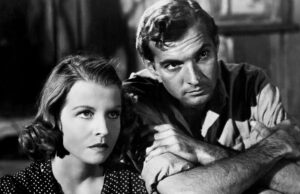

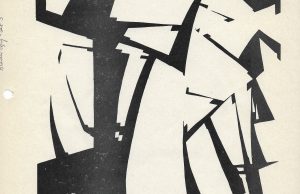






Leave a Reply